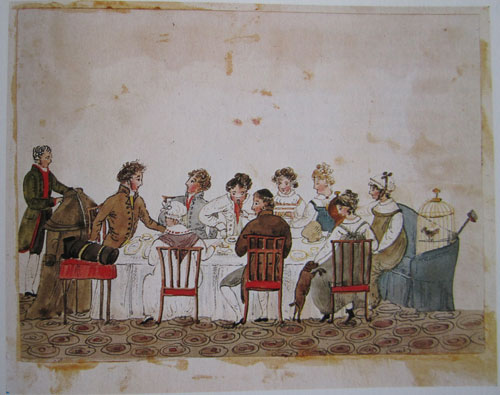 A fancy dinner party in Regency England would often have numerous dishes and courses. As has been true for over a century, French chefs were also a prized culinary asset to any kitchen, known for creating delicate and delicious sauces to dress a variety of fowl, fish, vegetables and more. In The French Cook (1822), we have a delightful discourse on the art of removes and French cuisine. First, the author tells us there are seven classes of foods or courses and that for a dinner party of eight “you cannot send up less than four entrees, a soup and a fish”. He goes into somewhat confusing detail by saying:
A fancy dinner party in Regency England would often have numerous dishes and courses. As has been true for over a century, French chefs were also a prized culinary asset to any kitchen, known for creating delicate and delicious sauces to dress a variety of fowl, fish, vegetables and more. In The French Cook (1822), we have a delightful discourse on the art of removes and French cuisine. First, the author tells us there are seven classes of foods or courses and that for a dinner party of eight “you cannot send up less than four entrees, a soup and a fish”. He goes into somewhat confusing detail by saying:
Symmetry seems to be paramount, so that a dish of petit pates is matched by croquettes.
For twelve or fourteen persons, for instance:
In whimsical, and often hilariously delusional fashion, the author goes on to say that Cookery was invented by the French therefore its natural that the French excel at it. After a lengthy perusal, that innate skill does not extend in this case to an easy to understand recipe or instruction book, but its nonetheless a charming and useful reference. The history of removes is a complicated one that owes something to semantics. Traditionally a remove was meant to mean a dish that was removed from the table and usually replaced by another dish. That was not to say that all dishes were removed from the table, as the term course would imply. Instead, the dinner party table was often set with an entire table full of food starting in the center from prominence to the outer edges of the table (hors d’oeuvres, etc) (LanguageofFood). Courses as we now know it wouldn’t become de rigeur until the 19th century with the à la Russe style of dining meant to keep food served hot and fresh (LanguageofFood).
For practical considerations on costs and how to set the table, young ladies would soon have an invaluable reference in Domestic duties; or, Instructions to young married ladies by Mrs. William Parkes (1825). She gives us a run down of the average cost for a dinner of 16-20 persons: which also tells us a little bit about what might be served. If a young lady is anxious on how to actually set the table, she is quickly advised:
Removes, as we begin to see by reading through the lines of the Regency contemporary text was as much about being an accomplished host/hostess and displaying wealth and elegance as it ever was about the actual food (although the French chef would have been quick to argue with the nicety of that sentiment). I also wonder if the style of cooking, particularly heating and baking, didn’t influence the way food was served. I have always been a bit baffled at kitchen being so far removed from dining rooms and the logistics of getting food from a to b without spilling, growing cool, or losing its presentation. I like to think of removes a bit like Thanksgiving dinner, where a delicate dance of timing is being executed in the kitchen so that when everyone sits down to chow, the turkey, mashed potatoes and other hot and cold items are in perfect harmony (and temperature). First, it is necessary to have extra hands not only whipping, mashing, carving and ladling, but also carrying, setting, and dressing the table. Servants would be instrumental in making sure this dance was a beautiful and seamless as possible. In a changing household, most notably the slow diminishment of household staff, courses would be a much simpler affair to manage, requiring less hands on deck at once. Although I haven’t studied this at length or depth to really make this argument, I know that for the average dinner at my house courses are often easier to manage than a grand affair like we see on Thanksgiving.










Fascinating. I occurs to me that the daughter of an aristocratic family, who learned this stuff from her mother, was probably better prepared than the son of the family, who had a commission bought for him with no idea what was involved in warfare or any military activity.
Absolutely. Especially when a ladies education was focused almost solely on accomplishments, including household management, whereas a gentleman’s education would have been focused on things like Classics.
I think in many cases, the food was not hot as it would have liked to be on table. They did have braziers on the side to keep things warm as well.
Excellent point about the braziers. Having done a little sterno serve and keep warm, I can’t imagine it was super effective.